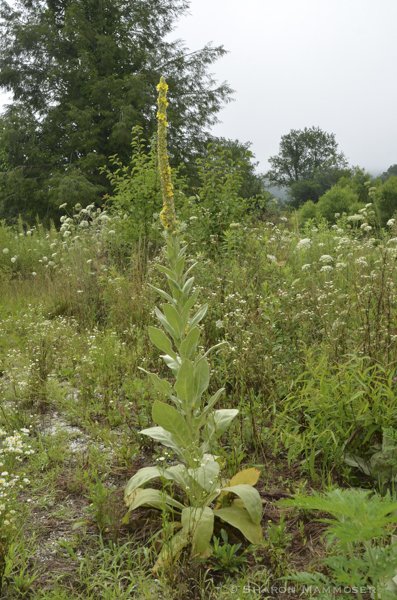Did you recognize the tall, spiky plant from last week’s puzzler as Mullein, or Verbascum thapsus ? According to Encyclopedia.com, some common names of mullein include ” flannel leaf, beggar’s blanket, velvet plant, felt-wort, tinder plant, candlewick plant, witch’s candle, Aaron’s rod, lady’s foxglove , donkey’s ears, hag’s taper, candlewick plant, torches, and Quaker rouge. This last name was given because the leaves were sometimes used as a natural rouge rubbed vigorously on the cheeks to give a rosy glow, particularly among young women whose cultures have shunned cosmetics.”
According to Encyclopedia.com, some common names of mullein include ” flannel leaf, beggar’s blanket, velvet plant, felt-wort, tinder plant, candlewick plant, witch’s candle, Aaron’s rod, lady’s foxglove , donkey’s ears, hag’s taper, candlewick plant, torches, and Quaker rouge. This last name was given because the leaves were sometimes used as a natural rouge rubbed vigorously on the cheeks to give a rosy glow, particularly among young women whose cultures have shunned cosmetics.”
Some of reasons for these common names are obvious–the leaves are super soft–hence flannel leaf, beggar’s blanket, velvet plant. The other names–hag’s taper, candlewick plant, torches, witch’s candle, come from the long stalk-like part of the plant. Ancient Romans removed the leaves and dipped the stalk in wax, then used it as a torch.
According to gardeningknowhow.com, “mullein was historically used as an herbal treatment for coughs, congestion, chest colds, bronchitis and inflammation. Native Americans and soldiers during the Civil War era made teas from leaves of mullein plants to treat asthma. During the 1800’s, settlers used their compounds to treat tuberculosis.”
There are 250 different species of mullein, a plant in the figwort family. One plant is said to produce over 100,000 seeds each YEAR! And amazingly, these seeds can remain dormant in the ground until conditions are right, for up to 100 years! Mullein grows in full sun, usually found in waste areas, abandoned fields, in ditches and on rocky banks, in gravel lots.
Here’s the next puzzler--yet another plant found in wild meadows.

